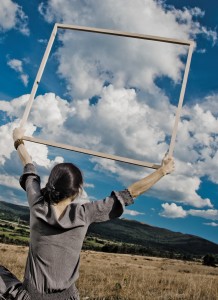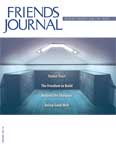Use the media player above or right-click here to download an audio version of this article.
Fe-maleness from My Personal Experience
For much of my life, I was what I would describe as a masculine female. While I considered myself Christian, I was a scientific materialist, both personally and professionally. I relied on observation, data, and reason to make decisions. I didn’t have access to, understand, or trust my intuition and emotions. I preferred to have male rather than female friends, and I enjoyed spending time with books more than with people. I was assertive, goal-oriented, and did not listen well (but thought I did).
 After becoming a Quaker, I had a spiritual experience that encouraged me to recognize the reality of inward guidance and to commit to a spiritual discipline. Initially, the spiritual discipline helped me to perceive my intuition and begin to understand its wisdom. Also, it indirectly opened me up to my emotions so I could start to learn from them. After almost a decade of daily inward attention and work (both psychological and spiritual), I have come to better perceive, trust, and orient my life around the guidance of the Spirit.
After becoming a Quaker, I had a spiritual experience that encouraged me to recognize the reality of inward guidance and to commit to a spiritual discipline. Initially, the spiritual discipline helped me to perceive my intuition and begin to understand its wisdom. Also, it indirectly opened me up to my emotions so I could start to learn from them. After almost a decade of daily inward attention and work (both psychological and spiritual), I have come to better perceive, trust, and orient my life around the guidance of the Spirit.
Now, I consider myself a fe-male, a person who has the capacity to draw upon both her feminine and masculine qualities. I look inwardly to find truth and value my emotions. I attend to the Spirit, then, after using my intellect to understand my experience, I act on the insight I receive. I listen to others, strive for mutuality in relationships, and know that who I am is born out of community. Looking back, I see that I have been—and am continuing to be—transformed by and into the likeness of a fe-male God.
Fe-maleness in the Bible
In Genesis 1:27, we read that God created humans in God’s image, with that image being male and female:
So God created humankind in his image, in the image of God he created them; male and female he created them.
As the terms male and female in our culture are often used to refer to sexual persons, we tend to think that this text refers to God creating male and female bodies. However, as the notes in the New Oxford Annotated Bible suggest, image relates not to physical characteristics but to relationship and activity. I believe this scripture is referring not to sexual bodies but to God creating humans with the capacity to relate and act like God does. It is suggesting that God’s nature includes both masculine and feminine characteristics and that we—each of us—are masculine and feminine.
God is revealed as masculine and feminine through relationship and activity many times in the Old Testament. In Exodus 3, God responds to the Israelites living in oppression in Egypt.
Then the Lord said, “I have observed the misery of my people who are in Egypt; I have heard their cry on account of their taskmasters. Indeed, I know their sufferings, and I have come down to deliver them from the Egyptians.”
God is like a mother: God is attuned to, hears, and responds to the cries of Her children. In addition, God has felt their suffering. This God is so close to these people that their feelings arouse Hers. God is also shown to display typically masculine traits—the capacity to be decisive and action-oriented. Once God’s compassion is aroused, God finds Moses and persuades him to act. Then through Moses, God acts and accomplishes His goal. God is shown to be both feminine and masculine, as God’s compassion is married with purpose to resolve injustice.
Our upbringing and culture emphasize our being either masculine or feminine, making realization of both capacities within ourselves an especially challenging task. The non-canonical Gospel of Thomas helps us to better understand the intellectual aspect of that challenge with this riddle in saying 22:
Jesus said to them, “When you make the two into one, and when you make the inner like the outer and the outer like the inner, and the upper like the lower, and when you make male and female into a single one, so that the male will not be male nor the female be female, when you make eyes in place of an eye, a hand in place of a hand, a foot in place of a foot, an image in place of an image, then you will enter [the <Father’s> domain].”
For me, this text suggests that there is a dual nature to reality, an inner/upper spiritual aspect and an outer/lower physical aspect. I believe the text is arguing that we can more accurately perceive reality when we bring these aspects together and see them as two parts of a whole. Likewise, the text urges us to bring together feminine and masculine qualities and to act outwardly in those ways we have learned inwardly.
When we get to the punch line, “when you make . . . an image in place of an image, then you will enter [the <Father’s> domain],” we can imagine that image relates to appearance—what is seen and what is unseen. Therefore, my interpretation of the riddle is if we conceive that which is inward (unseen) and bring it out into reality (seen), then we enter God’s domain. Through accomplishing these inward tasks, we are enabled to co-create with God.
A scripture passage in Mark 10 is similar to the Thomas text. However, instead of talking about one male or female person, it refers to two people, a husband and a wife. Its underlying meaning helps us understand the importance of committed, intimate relationship for spiritual development. Jesus is responding to a question about divorce that was brought to him by the Pharisees.
However, in the beginning, at the creation, “God made them male and female. For this reason, a man will leave his father and mother and be united with his wife, and the two will become one person,” so they are no longer two individuals but “one person.” Therefore those God has coupled together, no one else should separate.
The text begins somewhat surprisingly with the creation story, then jumps to an obvious statement about people leaving their parents when they get married. Then it continues with the common expectation that after two people are married they will have sexual intercourse. The conclusion follows with a direct admonition that these married persons not be separated.
Without the previous discussion of the meaning of male and female, I believe we wouldn’t be able to recognize that Jesus was making a joke that most likely left his audience stunned.
As is still practiced by Catholic Christians and esoteric groups within the other major world religions, Jesus’s listeners would have believed that the highest levels of spiritual attainment are achieved outside of marriage through structured ascetic practices like celibacy. I believe Jesus is trying to convey that rather than separating ourselves from others, it is through joining with another being most intimately that we come to grw into our human capacities most fully. He is suggesting that committed intimacy rather than celibacy sets up the best conditions for male and female persons to become fe-male, fitted for co-creation with God.
Fe-maleness in Quaker Tradition
Within the Quaker tradition, we can find fe-male persons who co-created with God. I believe John Woolman employed both feminine and masculine qualities as he attempted to follow God’s guidance. In his journal, his inward and outward experiences are described in some detail.
In 1761, before his visit to a Native American town, Woolman met some American Indians in Philadelphia, Pennsylvania (they were likely Eastern Delaware Indians). In this passage from the eighth chapter of his published Journal, he describes his feelings prior to and as a result of meeting them.
Having many years felt love in my heart towards the natives of this land who dwell far back in the wilderness . . . in company . . . and in conversation . . . also by observations on their countenances and conduct, I believed some of them were measurably acquainted with that divine power which subjects the rough and froward will of the creature.
Woolman’s femininity and masculinity are both evident in this excerpt from his journal. His feminine capacities are exhibited as he notes his love and compassion for these native people. His masculine capacities are also clearly shown from his knowledge of the historical situation and his use of observation in formulating an understanding of them as a people and as persons.
After sitting with his concern for the Native people for over a year, he discerns with his meeting that he will visit them in a distant town where they live. In 1763, just prior to his departure, he receives the troubling news that hostile Native Americans have attacked a fort at Pittsburgh, Pa., and scalped prisoners.
Going again to bed, I told not my wife till morning. My heart was turned to the Lord for His heavenly instruction; and it was a humbling time to me. When I told my dear wife, she appeared to be deeply concerned about it; but in a few hours’ time my mind became settled in a belief that it was my duty to proceed on my journey.
Woolman, needing to quickly make a decision, relies upon his inward guide to determine what to do. He is open to and considers the concerns of Friends and his wife while also remaining aware of and desiring to honor the commitments he has already made. While he was conscious and considerate of his and others’ emotions and feelings, he does not allow those thoughts to override his capacity to stay centered so he can discern inwardly what God would have him do. Once he is settled in his mind as to what God wants him to do, with humility, he acts resolutely.
I believe Mary Dyer also drew from feminine and masculine qualities. Because she did not leave a journal, the quotes below rely on statements transcribed and published in 1661 by Edward Burroughs.
In 1658, the Massachusetts General Court passed a law that made all non-resident Quakers subject to arrest, imprisonment, and banishment “upon pain of death.” After being pardoned from a death sentence in August 1659, Dyer returned to Boston the following year and was once more sentenced to death by hanging. At her sentencing, she said:
I came in obedience to the will of God, the last General Court, desiring you to repeal your unrighteous laws of banishment upon pain of death; and that same is my work now, and earnest request, because ye refused before to grant my request, although I told you that, if you refused to repeal them, the Lord would send others of his servants to witness against them.
Prior to being killed, she said:
Nay, I came to keep blood-guiltiness from you, desiring you to repeal the unrighteous and unjust law of banishment upon pain of death made against the innocent servants of the Lord; therefore, my blood will be required at your hands, who wilfully do it. But for those that do it in the simplicity of their hearts, I desire the Lord to forgive them. I came to do the will of my Father, and in obedience to His will I stand, even to the death.
Dyer certainly had and used what I would consider masculine qualities. She spoke assertively, acted boldly, and was goal-oriented. She spoke directly to officers of the court while describing its law as unjust. She repeatedly came to Boston for the purpose of violating a law that was punishable by death and knowingly faced a public death twice. All the while, she was purpose-driven. Repeatedly, she states that she is calling the court, through obedience to God, to repeal the laws that limited Friends’ activity in Massachusetts.
Dyer’s behavior and words are also feminine in that they reveal a deep sense of compassion, not only for those being persecuted by the unjust laws, but also for those who were calling for, creating, and enforcing the laws. Dyer did not want the men condemning her to death to suffer during Judgment because they had killed her and other innocent people. She desired God be merciful to them.
The Religious Society of Friends has recognized from its inception that the Spirit of Christ inhabits both men and women. George Fox, after noting that Mary Magdalene was a prophet, said, “For the light is the same in the male, and in female, which comes from Christ, he by whom the world was made, and so Christ is one in all, and not divided.” While this insight has helped us to appropriately include men and women in the varied tasks associated with maintaining and growing our meetings and our society, I believe we have not adequately conveyed what people need to do to become co-creators with God.
I believe that to live as fully as God desires us to, each of us needs to seek, find, grow, and use the masculine and feminine qualities that are contained in the Seed within. Both are required for the challenges we are called to face. If God is fe-male, then so should we be. If we are sincere about finding and living in the Reign of Love, we need to encourage each other to seek union of the male and the female within and without through the means disclosed to us in the Bible and through God’s ongoing guidance. In this way, we will grow into God’s likeness and participate in God’s ongoing actions of creation and redemption in the world.




Peace and Progress! Thank you for sharing your journey inward. In a society that admonishes us for trusting ourselves and that encourages us to trust consumerism and untested logic, I applaud your openness. You have jettison the prevailing societal value to show-and-tell our growth through ostentatious consumerism and outward approval of what is popular. Truly, in the Quaker way, you have let The Inner Light guide and provide revelation. The layered complexity of our being, and that of The Creator of us all, gives us all a lifetime of wonderful journeys, if we embrace the task. In this article, you have taken the task by the reigns and been enlightened and well as enlightened folks like me.
Thank you. I’m wondering if you might also have a story to tell.